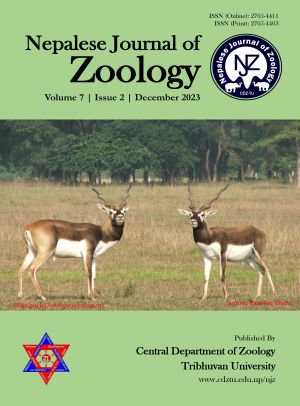Ecosystem engineering: Rufous-bellied woodpecker Dendrocopos hyperythrus (Vigors, 1831) modifying tree shapes of Himalayan broadleaved forests
DOI:
https://doi.org/10.3126/njz.v7i2.60802Keywords:
Ecosystem engineering, Himalayan temperate forests, Sap-wells, Tree modifications, Biodiversity indicatorAbstract
The study, conducted from 2005 to 2018, encompassed twelve sites in Nepal, including both protected and non-protected areas. The primary focus of the observations was on tree species, their shapes, structures, and their interactions with the rufous-bellied woodpecker. The rufous-bellied woodpecker in Nepal's Himalayas predominantly utilized specific tree species, notably oak (Quercus semecarpifolia and Q. glauca), birch (Betula utilis), Himalayan holly (Ilex dyperina), and maple (Acer species). These trees displayed a remarkable diversity in girth sizes, ranging from 0.5 meters to almost 2.5 meters, with tree heights varying from 5 to 30 meters. Among these, Quercus semecarpifolia was the preferred choice. Notably, rufous-bellied woodpeckers exhibited a distinctive behavior of drilling numerous small holes around tree trunks, often forming ring-like structures. These "sap-wells" were meticulously created by drilling dense rows of small holes encircling the tree trunks and served as the primary food source for the woodpeckers. They attracted a wide array of insects and offered a valuable source of protein. This continuous interaction between the woodpeckers and the trees resulted in unique modifications to the trunks of old-growth forest trees. Over time, the trees developed swollen trunks, and some trunks even displayed bending and deformations due to the woodpecker’s sap-well chiselling activities. Furthermore, the study observed several other bird species benefiting from these sap-wells created by the rufous-bellied woodpeckers. This observation underscores the broader ecological significance of these structures, benefiting a diverse range of species within the ecosystem. In essence, this study sheds light on the rufous-bellied woodpecker's role as an "ecosystem engineer" and an indicator of forest health in the temperate Himalayas, emphasizing its critical ecological importance.
Downloads
Downloads
Published
How to Cite
Issue
Section
License

This work is licensed under a Creative Commons Attribution-NonCommercial 4.0 International License.
This license enables reusers to distribute, remix, adapt, and build upon the material in any medium or format for noncommercial purposes only, and only so long as attribution is given to the creator.

